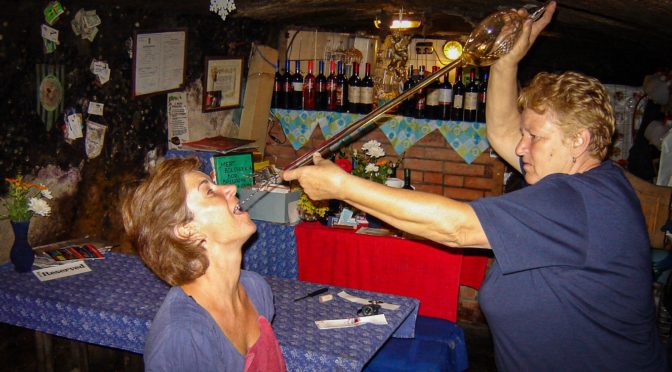North of Budapest and nestled in the curves of the winding River Danube is the pretty ‘artists’ town of Szentendre.
We spent an enjoyable day cycling along the river and exploring the area’s rural farmland and river villages. It’s on the tourists trail from Budapest but there were very few people around.

In 2011, locals told us the lack of visitors was down to the ‘economic crisis’ meaning that high unemployment in Hungary equalled little extra cash to spend on holidays. Coupled with the extortionate fuel prices (€1.50 litre) people were simply not willing to travel.
This was also the case at our stop at Lake Balaton – Europe’s largest and deepest inland lake outside of Scandinavia – where miles of holiday-making infrastructure was shut and boarded up, or half open and empty. It felt quite eerie.

Szentendre (pronounced similarly to Santander) should have been a honeypot. It’s a small circular town built up and around a hill topped with a simple pretty church. The streets were full of boutiques and artists’ studios and the houses are painted in pretty pastel colours, with tall tiled rooves.
We shared our first and only Langos – the local speciality – pizza sized fried dough topped with cheese and sour cream. We opted to share one which was a sensible decision as it seriously impeded our progress up the main hill.

Despite the town’s evident wealth and opportunity to attract tourists we were baffled as to the millions of euros which were being spent by the EU seemingly on pulling up the old cobbled streets to replace them with new replica ones.
It was an unusually hot day so our overall impression of the town was of dust and noise as the cobbling work drilled into and blocked the narrow, winding streets. July was the prime tourism month so the timing of this work was mystifying.

We moved onto Eger (pronounced Egg Air which, being a sulphuric thermal town, seemed comically appropriate). Founded in the 12th century with a fortress high on a hill it was the site of the Turks westernmost incursion in the 16th century and boasts Europe’s westernmost Ottoman minaret.
During the 17th and 18th centuries it flourished as a trading town on an important crossroads and many mansions, palaces, churches and public buildings were built. It must have been ravishingly lovely as the still-standing buildings were painted in stucco reds, pinks, blues and creams and the churches were topped with bulbous domes and towers.

Communist urban planners had wrecked the skyline by putting up the all too familiar multi-storey apartment blocks but ignoring those from our viewpoint on top of the castle walls we could appreciate Eger’s setting amid vineyards and gently rolling countryside.
A visit to the mysteriously named ‘valley of beautiful women’ was a must. This turned out to be some 200 caves carved into a limestone escarpment formed in a horseshoe shape. For centuries it had been home to the area’s wine makers. The caves were still dark and atmospheric wine cellars, most of which had seating and a tasting menu presided over by a feisty and pushy woman selling bottles and barrels to passers-by.
The local vintage is Egri Bikaver, also known as ‘Bull’s Blood’, and so-called as the invading Turks believed it was what the Hungarians drank before fighting fierce pitched battles against them. It is a rich, deep red wine with a big, boozy finish.

On this Wednesday afternoon in July, we had the valley to ourselves and had to run the gauntlet of bored ‘beautiful women’, all summoning us in for a tasting.
We had a sample in a cave hosted by the crazy Terec (Theresa) who insisted on pouring it down our necks from a long glass flute called a pipette, having extracted it straight from the barrel.
In pidgin English and with lots of sign language on our part we spent an enjoyable two hours discovering that Terec’s daily life in the cave meant hosting large groups of tourists or corporate clients.

She said that it was very quiet that year but people still visited to buy the wine which was needed now, more than ever, to combat the blues of the “economic crisis”.
A little tipsy, she hugged us both fondly as we left to accommodate a group of boisterous and moustached Hungarian men who were clearly spending the late afternoon on the equivalent of a ‘bar crawl’. We had no doubt Terec could cope with them single-handedly and make a tidy profit.

The provenance of the area’s mysterious name now became apparent as the sun set pinkly across the white stone of the escarpment. Women sellers seated outside of the many caves sang out and called to visitors to come inside and sample the big boozy red ‘Bulls Blood’. A genial atmosphere accompanied the various groups and couples as they tottered and danced their way between the cellars.
For us though, the visit to Terec was enough and a wonderful way to end our stay in Hungary. We returned to Bertha without any money but with several litres of wine.
Early the next morning and surprisingly head-ache free we packed up and headed off to explore the mountains of Slovakia.
After our brush with the law in Budapest, we calculated that the police would be least likely to patrol the country’s remote northern border. That was the hope, anyway.


